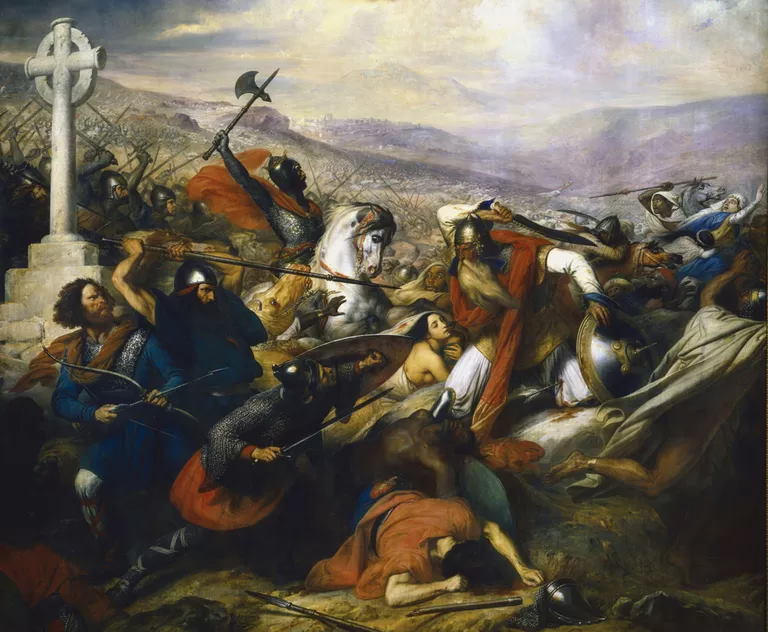The Battle of Tours was fought during the Muslim invasions of Western Europe in the 8th century.
In 711, the forces of the Umayyad Caliphate crossed into the Iberian Peninsula from Northern Africa and quickly began overrunning the region’s Visigothic Christian kingdoms. Consolidating their position on the peninsula, they used the area as a platform for commencing raids over the Pyrenees into modern-day France. Initially meeting little resistance, they were able to gain a foothold and the forces of Al-Samh ibn Malik established their capital at Narbonne in 720. Commencing attacks against Aquitaine, they were checked at the Battle of Toulouse in 721. This saw Duke Odo defeat the Muslim invaders and kill Al-Samh. Retreating to Narbonne, Umayyad troops continued raiding west and north reached as far as Autun, Burgundy in 725.
In 732, Umayyad forces led by the governor of Al-Andalus, Abdul Rahman Al Ghafiqi, advanced in force into Aquitaine. Meeting Odo at the Battle of the River Garonne they won a decisive victory and commenced sacking the region. Fleeing north, Odo sought aid from the Franks. Coming before Charles Martel, the Frankish mayor of the palace, Odo was promised aid only if he promised to submit to the Franks. Agreeing, Martel began raising his army to meet the invaders. In the years previous, having assessed the situation in Iberia and the Umayyad attack on Aquitaine, Charles came to believe that a professional army, rather than raw conscripts, was needed to defend the realm from invasion. To raise the money necessary to build and train an army that could withstand the Muslim horsemen, Charles began seizing Church lands, earning the ire of the religious community.
Battle of Tours – Moving to Contact
Moving to intercept Abdul Rahman, Charles used secondary roads to avoid detection and allow him to select the battlefield. Marching with approximately 30,000 Frankish troops he assumed a position between the towns of Tours and Poitiers. For the battle, Charles selected a high, wooded plain which would force the Umayyad cavalry to charge uphill through unfavorable terrain. This included trees in front of the Frankish line which would aid in breaking up cavalry attacks. Forming a large square, his men surprised Abdul Rahman, who did not expect to encounter a large enemy army and forced the Umayyad emir to pause for a week to consider his options. This delay benefited Charles as it allowed him to summon more of his veteran infantry to Tours.
Battle of Tours – The Franks Stand Strong
As Charles reinforced, the increasingly cold weather began to prey on the Umayyads who were unprepared for the more northern climate. On the seventh day, after gathering all of his forces, Abdul Rahman attacked with his Berber and Arab cavalry. In one of the few instances where medieval infantry stood up to cavalry, Charles’ troops defeated repeated Umayyad attacks. As the battle waged, the Umayyads finally broke through the Frankish lines and attempted to kill Charles. He was promptly surrounded by his personal guard who repulsed the attack. As this was occurring, scouts that Charles had sent out earlier were infiltrating the Umayyad camp and freeing prisoners and enslaved people.
Believing that the plunder of the campaign was being stolen, a large part of the Umayyad army broke off the battle and raced to protect their camp. This departure appeared as a retreat to their comrades who soon began to flee the field. While attempting to stop the apparent retreat, Abdul Rahman was surrounded and killed by Frankish troops. Briefly pursued by the Franks, the Umayyad withdrawal turned into a full retreat. Charles re-formed his troops expecting another attack the next day, but to his surprise, it never came as the Umayyads continued their retreat all the way to Iberia.
Aftermath
While exact casualties for the Battle of Tours are not known, some chronicles relate that Christian losses numbered around 1,500 while Abdul Rahman suffered approximately 10,000. Since Martel’s victory, historians have argued over the battle’s significance with some stating that his victory saved Western Christendom while others feel that its repercussions were minimal. Regardless, the Frankish victory at Tours, along with subsequent campaigns in 736 and 739, effectively stopped the advance of Muslim forces from Iberia allowing the further development of the Christian states in Western Europe.
Sources
Source: https://www.thoughtco.com/muslim-invasions-battle-of-tours-2360885
Hickman, Kennedy. “Muslim Invasions of Western Europe: The 732 Battle of Tours.” ThoughtCo, Nov. 20, 2020, thoughtco.com/muslim-invasions-battle-of-tours-2360885.







